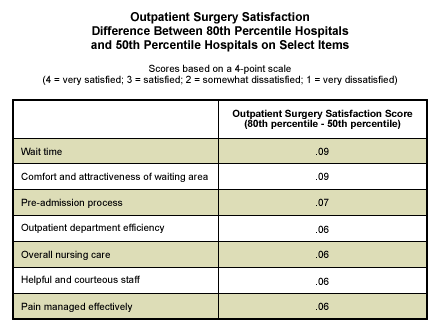Since 2000, outpatient surgery has consistently recorded the highest patient satisfaction scores among the four hospital service areas that Gallup measures. That's the good news. The not-so-good news is that those scores have remained static over the past four years, while those for inpatient areas have at least seen incremental improvement. How can outpatient surgery facilities improve?
To answer that question, Gallup looked at what differentiates the best outpatient surgery facilities (those scoring in the 80th percentile of the Gallup database) from the average facilities (those scoring in the 50th percentile).
The patient satisfaction items that best differentiate between 80th percentile hospitals and 50th percentile hospitals are: wait time, comfort/attractiveness of waiting area, satisfaction with the pre-admission process, outpatient department efficiency, quality of overall nursing care, helpfulness/courteousness of staff, and pain management. The first four items are "process" issues, tied most strongly to hospital policies and operations, and the last three items are "people" issues, tied most strongly to the performance of the employees themselves.

Process Items
Although the process items vary the most between best-practice and average facilities, these three questions (wait time, comfort/attractiveness of waiting area, and pre-admission process) have comparatively low correlations to patients' overall satisfaction with outpatient surgery facilities.
This could be a clue to why outpatient surgery satisfaction scores have been flat since 2000. When consulting onsite, I've often noticed that hospitals seeking to increase patient satisfaction scores look first to improving the physical facility and waiting times. Improvements in these areas are relatively easy to implement and evaluate. The danger is in assuming that concentrating improvement efforts on process issues exclusively will have a big impact on patients' overall impressions of the facility.
Process improvements are not unimportant. Patient perceptions of outpatient surgery department efficiency, for example, are key to overall patient satisfaction. But there is more to outpatient department efficiency than just waiting time. Other important areas include transitioning patients efficiently from one phase of the outpatient surgery process to the next, and demonstrating smooth coordination between departments and outpatient surgery team members.
People Items
The three people items that most differentiate the best facilities from the average ones -- overall nursing care, helpfulness and courteousness of staff, and pain management – also show the greatest relationship with overall outpatient surgery patient satisfaction.
It's no surprise that pain management is a key differentiator in outpatient surgery ratings. What do the best hospitals do differently in this area? Those who are best at pain management know that it is not enough to use a pain scale to assess pain levels. Average facilities use a pain scale and then react to patient-initiated requests for pain support or medication. The best take a more proactive approach. They do not wait on the patient request; rather, they look for more subtle signals and initiate action on pain. They also recognize that emotional support, not just medication, is a key element of pain management.
Excellent pain management represents a strong first step toward patient perceptions of helpful staff and excellent nursing care. Other tips for outpatient surgery facilities seeking to improve their staff's performance include the following:
- Greet the patient and family upon entry into the facility. Determine names they like to be called.
- During treatment, implement anticipatory communication by explaining each step in the coming process in advance. As one step in the process is completed, inform the patient of the results and see that the information is also relayed to the family.
- At each stage in the process, personalize the communication by using the patient's and family members' names.
Bottom Line
Don't fall into the process trap. Learn from what the best do differently, especially when it comes to the people issues.